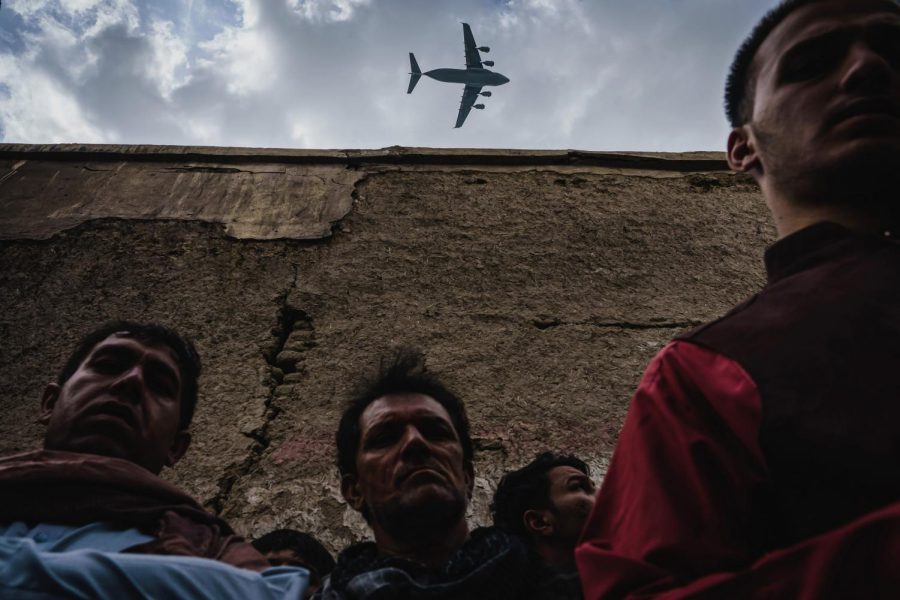Opinion | Western cultures need to stop normalizing violence in the Middle East
Marcus Yam, Los Angeles Times, TNS
A plane flies overhead a group of people gathered around the remains of a car hit by an American drone strike in Kabul, Afghanistan.
September 1, 2021
Young people in western cultures often think of the Middle East, Central Asia, Southwest Asia and North African regions as violent places, full of terrorists and unsafe for travel. They view the people there as poor and their homes as disaster-ridden places. Every time conflict in the region escalates, these stereotypes are perpetrated.
The last U.S. military planes left Kabul on Monday, leaving thousands of Afghan citizens who helped American soldiers under the Taliban’s control. Many Americans are avoiding discussing their own country’s involvement in the conflict — convincing themselves that the Middle East is just a violent place.
These views aren’t a mistake. Think about how the media presents this region, especially during our lifetimes — famine, war, poverty, discrimination against women and more. While they are the same problems every other nation faces, there is too much focus on them in these regions in the media.
For example, dozens of significant advances in archaeology and anthropology are made in the region every year, Lebanon legalized medical marijuana and an all-girl Afghani robotics team made cheap mobile ventilators to help the fight against COVID-19.
Our generation wasn’t often exposed to media that says otherwise — that the Middle East is more than just the world’s center of war. If you’re in your early 20s like me, world history was basically defined by the ongoing war in Afghanistan. Most of the soldiers that were killed in the Kabul airport suicide bombing on Aug. 26 were babies when the war in Afghanistan started.
My generation is more than familiar with Islamophobia. However, Islamophobia was nothing new even before 9/11. The western fear of the eastern “other” has existed for centuries. Western ideas about the Middle East are simple and narrow-minded — originating from persistent ignorance of the region’s cultures and religions.
Ideas of east versus west have existed for thousands of years. As far back as the fifth century BC, during the Greco-Persian war, Greece — in the west — deemed themselves the norm. They viewed the Persians in the east as violent, barbaric and unsophisticated.
Not surprisingly, the empires of the east and west weren’t monoliths and those stereotypes often were untrue. For example, the Persian Empire leaned heavily into religious freedoms, while Greece was home to the infamous Spartans — some of the most violent and formidable warriors of the time. It almost seems as though the stereotypes should have been reversed, and these motifs of east versus west still exist in the media today.
The Middle East, Central Asia and the SWANA region were highly sought after territories for hundreds of years. From battles over religion, to the waxing and waning of empires, the area has gone through many transitions of power. Arguably, it would make sense for it to be the fragmented, politically insatiable region that frequents the evening news today.
Although it may be presented as such, the Middle East wasn’t always this way. In fact, we owe some of humanity’s most important scientific innovations, literature, artwork, architecture and Islam — the second largest religion in the world — to the Middle East.
Despite hundreds of years of on and off conflict, there are plenty of time periods in the Middle East comparable to life in the Golden Ages of Paris, Rome, London or New York. In fact, just 50 years ago, Afghanistan experienced its very own golden age.
Cultural differences are always going to be difficult for people to tackle, but they can be found everywhere — between New York and Los Angeles for example, which are, funnily enough, another example of cultural differences between east and west. And there is absolutely a large cultural difference between, say, Pittsburgh and Kabul.
But just because there are differences doesn’t mean that we aren’t all people in need of food, water, safety and shelter. It doesn’t mean that violence in the Middle East should be accepted as normal or that violence should be the only thing presented about the Middle East in the media.
Dalia Maeroff writes primarily about issues of psychology, education, culture and environmentalism. Write to her at [email protected].









